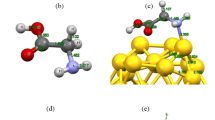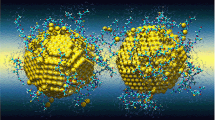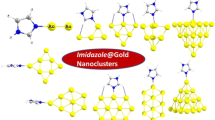Abstract
The effects of varying nanoparticle size; polyethylene glycol (PEG) molecule length, type, and density; and functional groups for drug delivery systems are investigated computationally. A molecular dynamics (MD) study in the framework of a Monte Carlo simulated annealing scheme is done on gold nanoparticles (Au NPs) for sizes of 2.6 nm, 3.4 nm and 6.8 nm. The bonding of PEG molecules is investigated, and the binding energy (BE) is analysed as a reference to chemisorption and physisorption of the molecules. To investigate the frontier molecular orbitals and molecular electrostatic potentials, density functional theory (DFT) simulations are also performed for various PEG lengths and functional groups (FGs). The study reports on three conclusions: firstly, reducing the Au NP size leads to coordination number (CN) loss as the number of lowly coordinated atoms increases with decreasing particle size. Secondly, the stability of the Au-PEG system is independent of length beyond \(n=2\). And due to PEG high steric repulsion, the number of these molecules that can be physically adsorbed to the surface is limited. And thirdly, the FGs can be grouped into electron-withdrawing group (–NTA, Biotin, COOH) and electron-donating group (–NH2, OH). In future work, we will study how these conclusions influence the Au drug delivery system toxicity and cellular uptake.









Similar content being viewed by others
Data availability
Not applicable.
References
Rojo J, Sousa-Herves A, Mascaraque A (2017) Perspectives of carbohydrates in drug discovery. Compr Med Chem III(1–8):577–610. https://doi.org/10.1016/B978-0-12-409547-2.12311-X
Jain KK (2020) An overview of drug delivery systems. In: Jain K (ed) Drug delivery systems. Methods in molecular biology, vol 2059. Humana, New York, pp 1–59. https://doi.org/10.1007/978-1-4939-9798-5_1
Shah A, Aftab S, Nisar J, Naeem M, Jan F (2021) Journal of Drug Delivery Science and Technology Nanocarriers for targeted drug delivery. J Drug Deliv Sci Technol 62:102426. https://doi.org/10.1016/j.jddst.2021.102426
Wanat K (2020) Biological barriers, and the influence of protein binding on the passage of drugs across them Drug-protein binding. Mol Biol Rep 47:3221–3231. https://doi.org/10.1007/s11033-020-05361-2
Jin H, Huang W, Zhu X, Zhou Y, Yan D (2012) Biocompatible or biodegradable hyperbranched polymers: from self-assembly to cytomimetic applications. Chem Soc Rev 41:5986–5997. https://doi.org/10.1039/c2cs35130g
Zhang X, Wang S, Xu L, Feng L, Ji Y, Tao L, Li S, Wei Y (2012) Biocompatible polydopamine fluorescent organic nanoparticles: facile preparation and cell imaging. Nanoscale 4:5581–5584. https://doi.org/10.1039/c2nr31281f
Kinnear C, Moore TL, Rodriguez-Lorenzo L, Rothen-Rutishauser B, Petri-Fink A (2017) Form Follows function: nanoparticle shape and its implications for nanomedicine. Chem Rev 117:11476–11521. https://doi.org/10.1021/acs.chemrev.7b00194
Sethi M, Sukumar R, Karve S, Werner ME, Wang EC, Moore DT, Kowalczyk SR, Zhang L, Wang AZ (2014) Effect of drug release kinetics on nanoparticle therapeutic efficacy and toxicity. Nanoscale 6:2321–2327. https://doi.org/10.1039/c3nr05961h
Zeeshan A, Farhan M, Siddiqui A (2014) Nanomedicine and drug delivery: a mini review, International. Nano Lett 4:1–7. https://doi.org/10.1007/s40089-014-0094-7
Chavali MS, Nikolova MP (2019) Metal oxide nanoparticles and their applications in nanotechnology. SN Appl Sci 1(2019):1–30. https://doi.org/10.1007/s42452-019-0592-3
Yaqoob AA, Ahmad H, Parveen T, Ahmad A, Oves M, Ismail IMI, Qari HA, Umar K, Ibrahim MNM (2020) Recent advances in metal decorated nanomaterials and their various biological applications: a review. Front Chem 8:1–23. https://doi.org/10.3389/FCHEM.2020.00341/FULL
Khan I, Saeed K, Khan I (2019) Nanoparticles: properties, applications and toxicities. Arab J Chem 12:908–931. https://doi.org/10.1016/j.arabjc.2017.05.011
Tao C (2018) Antimicrobial activity and toxicity of gold nanoparticles: research progress, challenges and prospects. Lett Appl Microbiol 67:537–543. https://doi.org/10.1111/lam.13082
Palombo M, Deshmukh M, Myers D, Gao J, Szekely Z, Sinko PJ (2014) Pharmaceutical and toxicological properties of engineered nanomaterials for drug delivery. Annu Rev Pharmacol Toxicol 54:581–598. https://doi.org/10.1146/annurev-pharmtox-010611-134615
Chen YS, Hung YC, Liau I, Huang GS (2009) Assessment of the in vivo toxicity of gold nanoparticles. Nanoscale Res Lett 4:858–864. https://doi.org/10.1007/s11671-009-9334-6
Choi SY, Jeong S, Jang SH, Park J, Park JH, Ock KS, Lee SY, Joo SW (2012) In vitro toxicity of serum protein-adsorbed citrate-reduced gold nanoparticles in human lung adenocarcinoma cells. Toxicol In Vitro 26:229–237. https://doi.org/10.1016/j.tiv.2011.11.016
Asharani PV, Lianwu Y, Gong Z, Valiyaveettil S (2011) Comparison of the toxicity of silver, gold and platinum nanoparticles in developing zebrafish embryos. Nanotoxicology 5:43–54. https://doi.org/10.3109/17435390.2010.489207
Chen H, Dorrigan A, Saad S, Hare DJ, Cortie MB, Valenzuela SM (2013) In vivo study of spherical gold nanoparticles: inflammatory effects and distribution in mice. PLoS One 8:1–8. https://doi.org/10.1371/journal.pone.0058208
Sperling RA, Parak WJ (2010) Surface modification, functionalization and bioconjugation of colloidal Inorganic nanoparticles. Philos Trans Royal Soc A: Math Phys Eng Sci 368:1333–1383. https://doi.org/10.1098/rsta.2009.0273
Adewale OB, Davids H, Cairncross L, Roux S (2019) Toxicological behavior of gold nanoparticles on various models : influence of physicochemical properties and other factors. Int J Toxicol 38:357–384. https://doi.org/10.1177/1091581819863130
Henz BJ, Chung PW, Andzelm JW, Chantawansri TL, Lenhart JL, Beyer FL (2011) Determination of binding energy and solubility parameters for functionalized gold nanoparticles by molecular dynamics simulation. Langmuir 27:7836–7842
Pengo P, Şologan M, Pasquato L, Guida F, Pacor S, Tossi A, Stellacci F, Marson D, Boccardo S, Pricl S, Posocco P (2017) Gold nanoparticles with patterned surface monolayers for nanomedicine: current perspectives. Eur Biophys J 46:749–771. https://doi.org/10.1007/s00249-017-1250-6
Ngake T, Nqayi S, Gulumian M, Cronjé S, Harris RA (2022) Recent developments in computational and experimental studies of physicochemical properties of Au and Ag nanostructures on cellular uptake and nanostructure toxicity. Biochim Biophys Acta (BBA) - General Subjects 1866:130170. https://doi.org/10.1016/J.BBAGEN.2022.130170
Vetten M, Gulumian M (2019) Differences in uptake of 14 nm PEG-liganded gold nanoparticles into BEAS- 2B cells is dependent on their functional groups. Toxicol Appl Pharmacol 363:131–141. https://doi.org/10.1016/j.taap.2018.11.014
Mabkhot YN, Aldawsari FD, Al-Showiman SS, Barakat A, Soliman SM, Iqbal Choudhary M, Yousuf S, Mubarak MS, Hadda TB (2015) Novel enaminone derived from thieno [2,3-b] thiene: synthesis, X-ray crystal structure, HOMO, LUMO, NBO analyses and biological activity. Chem Cent J 9:1–11. https://doi.org/10.1186/s13065-015-0100-9
Miar M, Shiroudi A, Pourshamsian K, Oliaey AR, Hatamjafari F (2021) Theoretical investigations on the HOMO–LUMO gap and global reactivity descriptor studies, natural bond orbital, and nucleus-independent chemical shifts analyses of 3-phenylbenzo[d]thiazole-2(3H)-imine and its para-substituted derivatives: Solvent and subs. J Chem Res 45:147–158. https://doi.org/10.1177/1747519820932091
Fukui K, Yonezawa T, Shingu H (1952) A molecular orbital theory of reactivity in aromatic hydrocarbons. J Chem Phys 20:722–725. https://doi.org/10.1063/1.1700523
Wang S, Yan X, Su G, Yan B (2021) Cytotoxicity induction by the oxidative reactivity of nanoparticles revealed by a combinatorial gnp library with diverse redox properties. Molecules 26:5986–5997. https://doi.org/10.3390/molecules26123630
Patra JK, Das G, Fraceto LF, Campos EVR, Rodriguez-Torres MDP, Acosta-Torres LS, Diaz-Torres LA, Grillo R, Swamy MK, Sharma S, Habtemariam S, Shin HS (2018) Nano based drug delivery systems: recent developments and future prospects. J Nanobiotechnol 16:1–33. https://doi.org/10.1186/s12951-018-0392-8
Li H, Li L, Pedersen A, Gao Y, Khetrapal N, Jónsson H, Zeng XC (2015) Magic-number gold nanoclusters with diameters from 1 to 3.5 nm: relative stability and catalytic activity for CO oxidation. Nano Letters 15:682–688. https://doi.org/10.1021/nl504192u
Harris RA (2022) The PEGylated and non-PEGylated interaction of the anticancer drug 5-fluorouracil with paramagnetic Fe3O4 nanoparticles as drug carrier. J Mol Liq 360:1–11. https://doi.org/10.1016/j.molliq.2022.119515
Reed JL (1997) Electronegativity: Chemical hardness I. J Phys Chem A 101:7396–7400. https://doi.org/10.1021/jp9711050
Pearson RG (2005) Chemical hardness and density functional theory RALPH. J Chem Sci 117:369–377
Kumar S, Saini V, Maurya IK, Sindhu J, Kumari M, Kataria R, Kumar V (2018) Design, synthesis, DFT, docking studies and ADME prediction of some new coumarinyl linked pyrazolylthiazoles: potential standalone or adjuvant antimicrobial agents. PLoS ONE 13:1–23. https://doi.org/10.1371/journal.pone.0196016
Blazhynska MM, Kyrychenko A, Kalugin ON (2018) Molecular dynamics simulation of the size-dependent morphological stability of cubic shape silver nanoparticles. Mol Simul 44:981–991. https://doi.org/10.1080/08927022.2018.1469751
Pauling L (1931) The nature of the chemical bond. Application of results obtained from the quantum mechanics and from a theory of paramagnetic susceptibility to the structure of molecules. J Am Chem Soc 455:1367–1400
Methfessel M, Hennig D, Scheffler M (1992) Calculated surface energies of the 4 d transition metals: A study of bond-cutting models. Appl Phys Solid Surf 55:442–448. https://doi.org/10.1007/BF00348331
Vollath D, Fischer FD, Holec D (2018) Surface energy of nanoparticles - influence of particle size and structure, Beilstein. J Nanotechnol 9:2265–2276. https://doi.org/10.3762/bjnano.9.211
Kokkin DL, Zhang R, Steimle TC, Wyse IA, Pearlman BW, Varberg TD (2015) Au-S bonding revealed from the characterization of diatomic gold sulfide, AuS. J Phys Chem A 119:11659–11667. https://doi.org/10.1021/acs.jpca.5b08781
Aihara JI (1999) Reduced HOMO-LUMO gap as an index of kinetic stability for polycyclic aromatic hydrocarbons. J Phys Chem A 103:7487–7495. https://doi.org/10.1021/jp990092i
Ruiz-Morales Y (2002) HOMO-LUMO gap as an index of molecular size and structure for polycyclic aromatic hydrocarbons (PAHs) and asphaltenes: a theoretical study. I J Phys Chem A 106:11283–11308. https://doi.org/10.1021/jp021152e
Manolopoulos DE, May JC, Down SE (1991) Theoretical studies of the fullerenes: C34 to C70. Chem Phys Lett 181:105–111. https://doi.org/10.1016/0009-2614(91)90340-F
Rambukwella M, Sakthivel NA, Delcamp JH, Sementa L (2018) Ligand structure determines nanoparticles’ atomic structure, metal-ligand interface and properties. Front Chem 6:1–7. https://doi.org/10.3389/fchem.2018.00330
Elias DR, Poloukhtine A, Popik V, Tsourkas A (2013) Effect of ligand density, receptor density, and nanoparticle size on cell targeting. Nanomedicine NBM 9:194–201. https://doi.org/10.1016/j.nano.2012.05.015
Harris RA, Mlambo M, Mdluli PS (2016) Qualitative analysis of some alkanethiols on Au nanoparticles during SERS. RSC Adv 6:12131–12142. https://doi.org/10.1039/c5ra24795k
Dudev M, Wang J, Dudev T, Lim C (2006) Factors governing the metal coordination number in metal complexes from cambridge structural database analyses. J Phys Chem B 110:1889–1895. https://doi.org/10.1021/jp054975n
Xiong X-G, Wang Y-L, Xu C-Q, Qiu Y-H, Wang L-S, Li J (2015) On the gold–ligand covalency in linear [AuX2]− complexes. Dalton Trans 44:5535. https://doi.org/10.1039/c4dt04031g
Anon, Coordination Numbers and Structures, (2021) 1–18. https://chem.libretexts.org/@go/page/151411 (accessed October 12, 2021)
Reimers JR, Ford MJ, Halder A, Ulstrup J, Hush NS (2016) Gold surfaces and nanoparticles are protected by Au(0)-thiyl species and are destroyed when Au(I)-thiolates form. Proc Natl Acad Sci U S A 113:E1424–E1433. https://doi.org/10.1073/pnas.1600472113
Zareie HM, Boyer C, Bulmus V, Nateghi E, Davis TP (2008) Temperature-responsive self-assembled monolayers of oligo(ethylene glycol): control of biomolecular recognition. ACS Nano 2:757–765. https://doi.org/10.1021/nn800076h
Qi W, Huang B, Wang M (2009) Bond-length and -energy variation of small gold nanoparticles. J Comput Theor Nanosci 6:635–639. https://doi.org/10.1166/jctn.2009.1085
Huang WJ, Sun R, Tao J, Menard LD, Nuzzo RG, Zuo JM (2008) Coordination-dependent surface atomic contraction in nanocrystals revealed by coherent diffraction. Nat Mater 7:308–313. https://doi.org/10.1038/nmat2132
Mlambo M, Harris RA, Mashazi P, Sabela M, Kanchi S, Madikizela LM, Shumbula PN, Moloto N, Hlatshwayo TT, Mdluli PS (2017) Computational and experimental evaluation of selective substitution of thiolated coumarin derivatives on gold nanoparticles: surface enhancing Raman scattering and electrochemical studies. Appl Surf Sci 396:695–704. https://doi.org/10.1016/j.apsusc.2016.11.011
Forest V, Pourchez J (2017) Preferential binding of positive nanoparticles on cell membranes is due to electrostatic interactions: a too simplistic explanation that does not take into account the nanoparticle protein corona. Mater Sci Eng, C 70:889–896. https://doi.org/10.1016/j.msec.2016.09.016
Funding
DSI grant number DSI/CON C2353/2021 and the National Research Foundations (NRF) grant number: PR_IFR220207659371.
Author information
Authors and Affiliations
Contributions
Mr. S. Nqayi (PhD candidate): simulation and modelling, collecting of data, writing of manuscript. Prof. M. Gulumian: co-supervisor, technical guidance, review of manuscript, grant holder. Dr. S. Cronje: co-supervisor, reviewing of manuscript. Prof. R.A. Harris: supervisor of Ph.D. candidate; assist with simulation and modelling, assist with writing/reviewing of manuscript, grant-holder.
Corresponding author
Ethics declarations
Ethics approval and consent to participate
Not applicable.
Consent for publication
All the authors as listed have consented to the manuscript’s publication.
Competing interests
The authors declare no competing interests.
Additional information
Publisher's note
Springer Nature remains neutral with regard to jurisdictional claims in published maps and institutional affiliations.
Rights and permissions
Springer Nature or its licensor (e.g. a society or other partner) holds exclusive rights to this article under a publishing agreement with the author(s) or other rightsholder(s); author self-archiving of the accepted manuscript version of this article is solely governed by the terms of such publishing agreement and applicable law.
About this article
Cite this article
Nqayi, S., Gulumian, M., Cronjé, S. et al. Computational study of the effect of size and surface functionalization on Au nanoparticles on their stability to study biological descriptors. J Mol Model 28, 376 (2022). https://doi.org/10.1007/s00894-022-05367-6
Received:
Accepted:
Published:
DOI: https://doi.org/10.1007/s00894-022-05367-6




